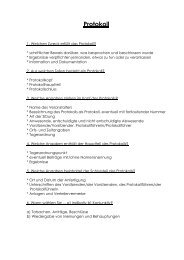ENVIRONMENT
You also want an ePaper? Increase the reach of your titles
YUMPU automatically turns print PDFs into web optimized ePapers that Google loves.
Name<br />
The Exxon Valdez Brings Danger to<br />
the Environment<br />
By Jane Runyon<br />
Oil is an important product<br />
in the world's economy. Oil is<br />
used to produce gasoline that<br />
makes cars and trucks run.<br />
Oil is used to heat homes in<br />
the winter. Byproducts of oil<br />
are used in chemical<br />
compounds to make<br />
everything from band-aids to<br />
plastic bottles. Oil is often<br />
transported from country to<br />
country around the world by<br />
large ships. One of these ships almost destroyed an entire living<br />
habitat.<br />
The Exxon Valdez left Valdez, Alaska, on March 24, 1989. This<br />
was a common trip for the oil tanker. It had just been filled with 52<br />
million gallons of oil and was headed south through Prince William<br />
Sound. The captain of the ship, Joseph Hazelwood, radioed the<br />
Coast Guard station in the area. His crew had spotted some small<br />
icebergs in the water that he hoped to avoid by taking a slightly<br />
changed route. The captain then went off to bed and left the ship in<br />
the hands of his third mate.<br />
The helmsman was given instructions to make a turn to the new<br />
course. The turn was not sharp enough. At 12:04 A.M., the Exxon<br />
Valdez struck Bligh Reef. Gallons of oil began to spill from the hull<br />
of the ship. It is estimated that approximately 11 million gallons of<br />
oil spilled into the sea before anything could be done to stop it.<br />
The United States Coast Guard was called. They immediately<br />
closed the Port of Valdez to all sea traffic. No ships were allowed to<br />
come into port and no ships were allowed to leave port.<br />
Environmental response teams were assembled. There was no doubt<br />
that that much oil was going to cause great danger to plant and<br />
animal life for miles around the spill.<br />
The Exxon Oil Company belonged to a group of seven oil<br />
companies called Alyeska. This group came forward and accepted<br />
responsibility for cleaning up the oil. They followed plans that had<br />
been set up for just such an emergency. Other groups joined<br />
Alyeska, the Coast Guard, and environmental teams in short order.<br />
It was decided that the groups had three options in trying to clean<br />
up the oil. They could burn it off, skim it off the surface with<br />
machines, or use chemicals to break the oil up and render it harmless.<br />
Burning the oil was tried first. Large booms, or floating barriers,<br />
were towed between two ships. These booms skimmed the oil off<br />
the top of the water. When the booms were full, the oil was set on<br />
fire. This method worked to a certain extent. Then the weather<br />
turned bad and the burning could no longer be used.<br />
Skimmers were brought to the clean-up site. Not many of these<br />
contraptions were available in the first few hours after the spill.<br />
Those that were brought to skim oil off the water soon clogged up<br />
with thick oil and seaweed. The machinery broke down often, and it<br />
took too much time for the skimmers to be repaired.<br />
Finally, it was time to try and disperse the oil with chemicals.<br />
Alyeska had only 4,000 gallons of the chemicals on hand. They had<br />
no way of spraying the chemical onto the oil. A helicopter was<br />
finally hired and dropped what chemicals it could. It was found that<br />
the chemicals were not mixing with the oil to disperse it, so that<br />
operation was stopped. It became apparent that cleaning up this<br />
huge mess was going to take a lot longer than anyone had hoped.<br />
In the meantime, environmental groups were trying to save any<br />
and all life that they could. Stations were set up in an attempt to<br />
clean birds whose feathers became covered by the sticky oil. It has<br />
been estimated that this one accident caused the immediate deaths of<br />
250,000 birds, 2,800 otters, 300 seals, 250 bald eagles, 22 killer<br />
whales, and billions of eggs of salmon and herring who made their<br />
homes in the seas of Prince William Sound. Researchers believe that<br />
it may take up to thirty years before the effects of the Exxon Valdez<br />
oil spill have been completely cleared up.<br />
The Exxon Valdez was towed to a repair port in San Diego. It<br />
was known around the world as the ship that caused a terrible oil<br />
spill. Is it any wonder that after repairs were complete that the ship<br />
returned to service under a new name?

















